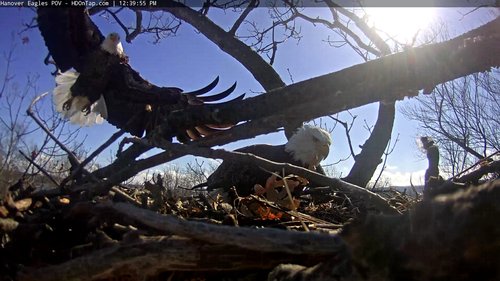Hanover Bald Eagle Blog # 7 - 2021
In partnership with Pennsylvania Game Commission and Comcast Business .

THIS WEEK THE HANOVER PAIR HAS BEEN DILIGENTLY WATCHING OVER THERE TWO EGGS, DEMONSTRATING NOTABLE SPATIAL AWARENESS DURING SHIFT SWAPS. ALTHOUGH THE EGGS ARE SOMETIMES LEFT UNATTENDED WHILE THE MALE AND FEMALE TRADE SPOTS, THESE SMALL LAPSES IN PARENTAL PRESENCE ARE NOT A THREAT TO THE EMBRYO. IN FACT, EGG EXPERT TIM BIRKHEAD POINTS OUT THAT EMBRYOS ARE MORE RESILIENT THAN PEOPLE GIVE THEM CREDIT FOR. THAT BEING SAID, THEY STILL NEED THEIR PARENT’S HELP TO BECOME HEALTHY HAPPY HATCHLINGS, AND THAT’S WHERE INCUBATION COMES IN.
Incubation serves the very important function of keeping the eggs warm. Bald eagle eggs are kept at a temperature of 105ºF (41ºC). To help with this transfer of warmth, both male and female bald eagles develop a brood patch, an exposed section of skin equipped with temperature sensors and blood vessels. After the eggs are laid, hormonal changes cause feathers to loosen and fall out in the appropriate area of the breast. When we see the Hanover parents wiggle from side-to-side as they position themselves atop the eggs, they are actually ensuring their brood patch makes full contact with the eggshells. Interestingly, not all breeding birds develop a brood patch. Some seabirds, such as the blue-footed booby, use their webbed feet to warm their eggs!

The male-female split between incubation duties is another behavioral pattern that differs between species. Black vultures, for example, swap shifts every 24 hours. Sharp-shinned hawk females do all the incubating themselves, as do northern harrier females. Bald eagles, as we know, share incubation duties, however the female usually takes the longer shifts overnight or during cold storms since she is larger than the male.
In addition to keeping the eggs warm, incubation serves several other purposes: First, it shades the eggs from harsh sunlight (hardly a problem this week). Second, parents need to be present at the nest to protect their eggs from predators. Eggs are nutritious and therefore a hot commodity in the winter and early spring when animals are hungry and scrounging. Luckily for bald eagles, they pack quite a punch, and have fewer nest predators than smaller, less intimidating species. However, great-horned owls, red-tailed hawks, gulls, fishers, raccoons, and a few other animals are known to try. Whichever Hanover parent is not incubating is likely remaining alert and watchful for nest predators and other bald eagles looking to usurp the Hanover territory. These kinds of altercations may be responsible for the occasional vocals we hear near the nest, especially at night when eagles likely feel more vulnerable.

There is another less visible danger that can befall a developing embryo: Losing access to the albumen, the colorless egg white that contains water and protein upon which embryos depend. To ensure that their developing chicks have access to the albumen, bird parents turn their eggs. This is especially critical in the first few days of incubation. In Birkhead’s words, turning the egg promotes “the development of the embryo’s network of external blood vessels, encouraging the diffusion of nutrients and water within the egg, and ensuring that the embryo is optimally positioned with respect to the yolk and albumen.” Since the eggs hatched, the Hanover parents have indeed been turning their eggs, usually once every hour or two, carefully balling their feet in the process so as not to puncture the egg.
Bird parents are remarkably adept at knowing exactly what their eggs need including when to turn them, when they’re too hot or too cold, and how to orient them so that when the chick breaks through it gulps air instead of straw.

Let us pay our respects to the marvel of incubation, and to do so, I will share a quote from a text written in 1678 by two seminal naturalists, John Ray and Francis Willughby, credited with publishing the first scientific book on birds: “With what courage and magnanimity do even the most cowardly birds defend their eggs…Stupendous in truth is the love of birds to a dull and lifeless egg.”
Note on egg color:
It is not uncommon for bald eagles to produce eggs with varying pigmentation. Therefore, the darker of the two Hanover eggs is not necessarily addled or nonviable, though it’s possible. We can only hope for the best, and see how the second egg fares come hatch time.
Sources
Birkhead, Tim (2017). The Most Perfect Thing. London, United Kingdom: Bloomsbury Publishing PLC.
Dr. Keith Bildstein, personal communication, 14 February 2021
Hancock, David. (2018). Eggs Incubation and Hatching. Hancock Wildlife Foundation.
https://hancockwildlife.org/hancock-wildlife-reference/bald-eagle-biology/eggs-incubation-hatching/
ATTENTION HANOVER EAGLE VIEWERS - We recognize that over the years this bald eagle pair has been named by the public and is commonly referred to as "Freedom" and "Liberty". While we understand that naming the eagles helps connect and distinguish the female from the male eagle, naming the pair introduces an element of domesticity to wild animals. In order to respect the eagles and focus on their natural history, we will refer to the female and male as such as per recommendations of the Pennsylvania Game Commission.



RETURN TO HANOVER BALD EAGLE BLOGS
WATCH THE HANOVER BALD EAGLE LIVE CAMS
For over 20 years, HDOnTap has provided live streaming solutions to resorts, amusement parks, wildlife refuges and more. In addition to maintaining a network of over 400 live webcams, HDOnTap specializes in design and installation of remote, off-grid and otherwise challenging live streaming solutions. Contact press@hdontap.com for all media needs, including images and recordings.